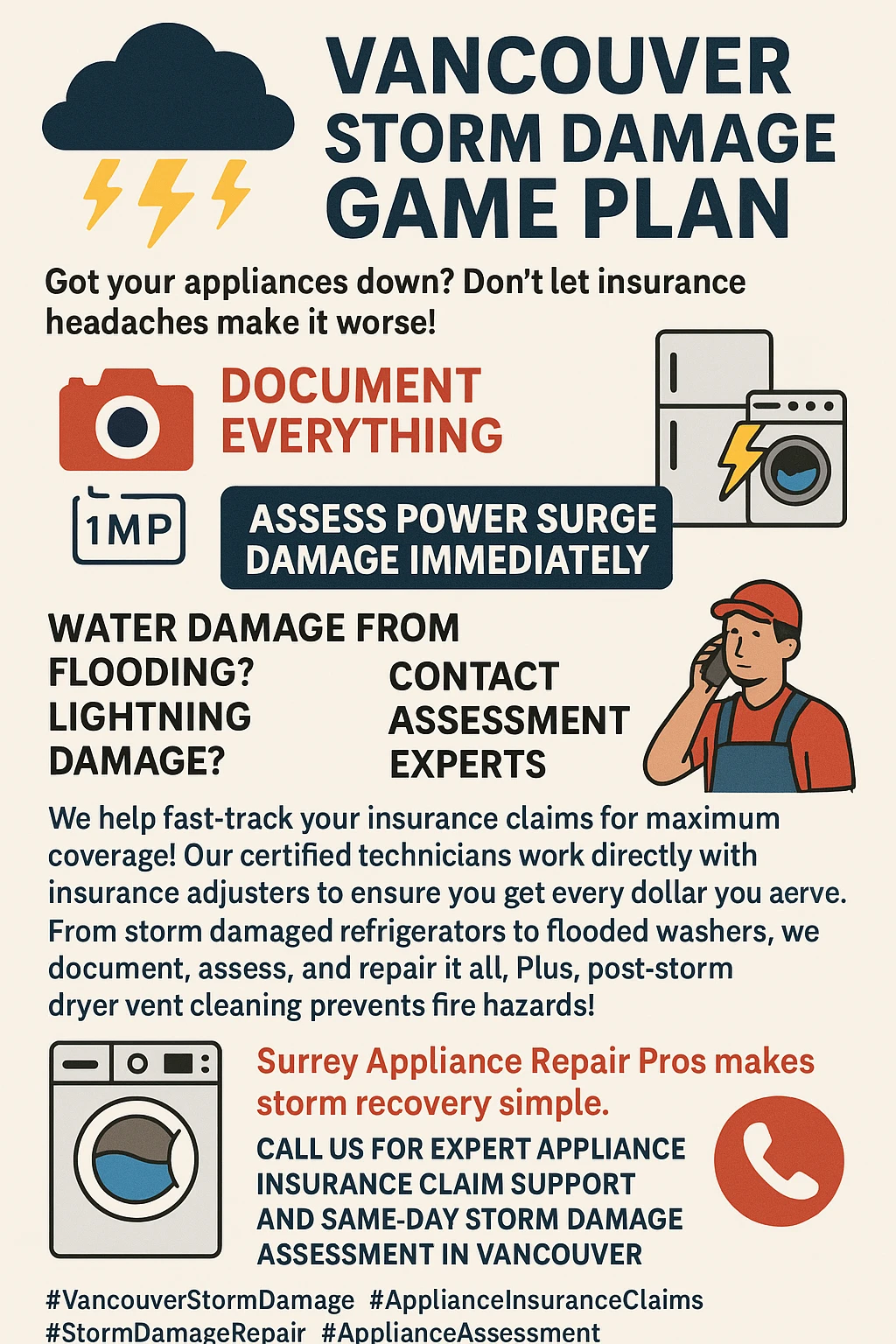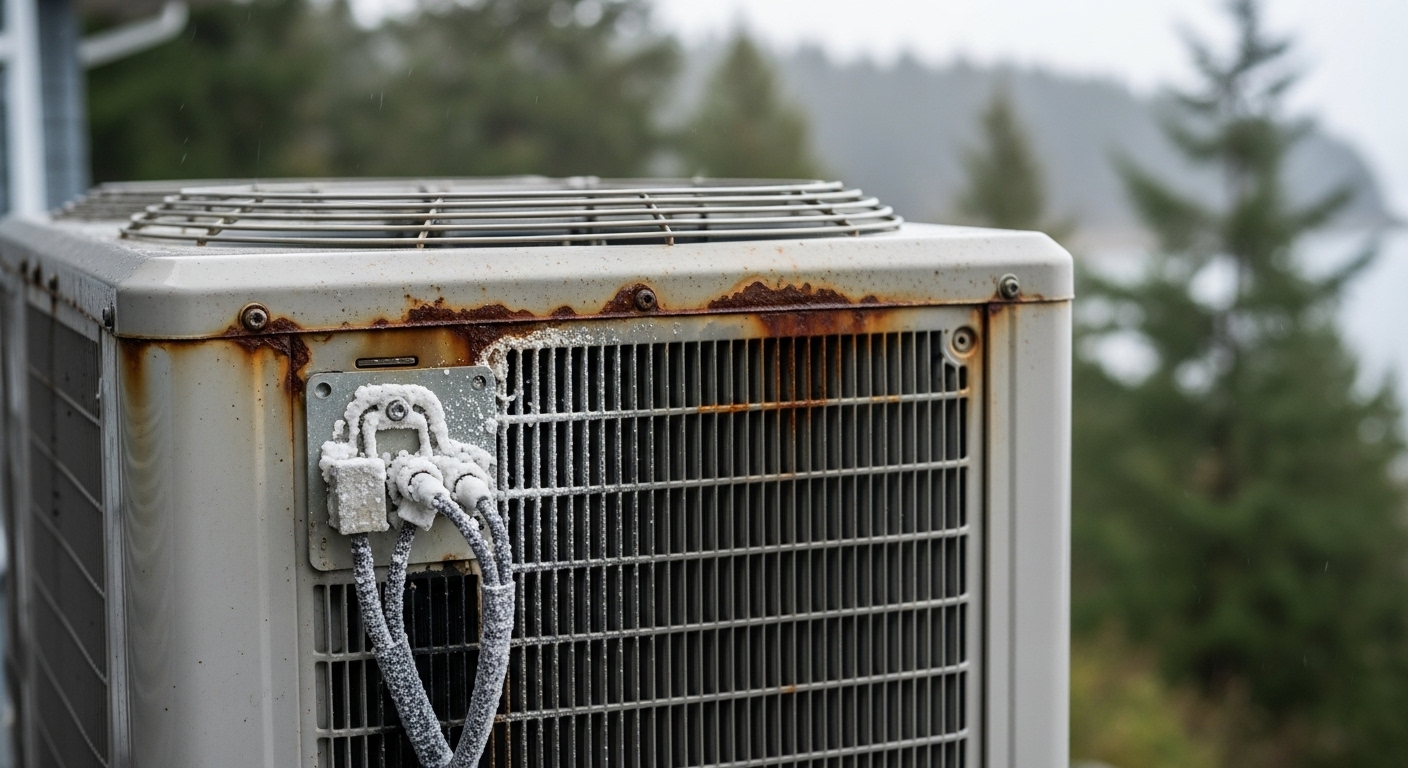Dealing with storm-damaged appliances and wondering if your Vancouver home insurance will actually cover the full replacement costs? You’re definitely not alone – many homeowners discover too late that improper documentation or missed filing deadlines can turn a covered claim into an expensive out-of-pocket repair bill that drains savings accounts.
Picture this: your three-year-old dishwasher suddenly floods your kitchen during Vancouver’s notorious November storms, causing water damage to your engineered hardwood floors and custom cabinets. You think you’re covered under your comprehensive homeowners policy, but six months later you’re still battling with your insurance company over depreciation calculations and coverage limits that seem designed to minimize payouts. Unfortunately, this frustrating scenario plays out in Vancouver homes more often than you’d think, especially with our city’s unique coastal climate creating appliance challenges that standard insurance policies don’t always address clearly. The wet marine air, frequent power outages, and aging electrical infrastructure create a perfect storm of appliance vulnerability that catches many homeowners completely off guard.
The reality is that successful appliance insurance claims require much more strategic thinking than just calling your agent and hoping for the best outcome. From understanding the critical difference between personal property and dwelling coverage to documenting Vancouver’s specific climate-related damage patterns, homeowners need a comprehensive approach to maximize their coverage and protect their financial interests. What makes Vancouver particularly tricky is our mix of older heritage homes with outdated wiring, modern strata regulations with shared responsibility complexities, and coastal conditions that create unique damage scenarios insurance adjusters from Alberta or Ontario don’t see in their typical day-to-day claims processing.
Whether you’re dealing with salt air corrosion slowly destroying your outdoor heat pump, electrical surge damage from BC Hydro fluctuations during storm restoration, or water damage from Vancouver’s aging infrastructure failing during heavy rainfall, understanding the complete claims process can mean the difference between full replacement coverage and a disappointing settlement that leaves you thousands of dollars short of actual replacement costs. The key is knowing exactly what documentation to gather within that critical first 24 hours, when to file your initial claim notification, and how to work strategically with adjusters who may not fully understand Vancouver’s specific housing challenges and environmental factors that accelerate appliance deterioration.
Key Outtakes
- Proper documentation within 24 hours of appliance damage significantly increases claim approval rates and settlement amounts
- Vancouver’s coastal climate creates unique appliance damage patterns requiring specialized documentation for salt air corrosion and humidity effects
- Home insurance covers appliances through personal property coverage (portable items) or dwelling coverage (built-in systems), with different limits and deductibles
- Strata and condominium appliance claims require additional documentation and coordination that’s unique to Vancouver’s high-density housing market
- Understanding depreciation calculations and replacement cost coverage can help homeowners negotiate settlements that reflect Vancouver’s premium appliance market pricing

Understanding Vancouver Home Insurance Coverage for Appliances
Before you can successfully file an appliance insurance claim in Vancouver, you need to understand exactly what your home insurance policy covers and how appliances are classified within those coverage categories. This classification system isn’t as straightforward as most homeowners assume, especially in Vancouver where our unique housing mix of heritage homes, modern condos, and complex strata regulations creates coverage complications that simply don’t exist in other Canadian markets. The insurance industry frankly hasn’t kept pace with Vancouver’s rapid housing evolution and technological advances, leaving many homeowners in frustrating gray areas when expensive appliances fail unexpectedly.
Most Vancouver home insurance policies classify appliances into two completely distinct categories that determine your coverage limits, deductibles, and ultimate payout amounts. Personal property coverage typically applies to portable appliances like refrigerators, washing machines, dryers, and standalone freezers that aren’t permanently attached to your home’s structure. These items are usually covered for approximately 50-70% of your dwelling coverage amount, which means if you have a $500,000 home, your personal property coverage might cap out somewhere between $250,000-$350,000 total for everything combined. However, this coverage amount is shared among absolutely all your belongings, so your expensive appliances must compete with furniture, electronics, clothing, and other personal items for the same limited coverage pool.

Dwelling coverage, on the other hand, applies specifically to built-in appliances that insurance companies consider integral parts of your home’s actual structure rather than removable personal property. This category includes systems like HVAC units, water heaters, built-in dishwashers, garbage disposals, and range hoods that are permanently installed and would typically remain with the property if you sold your home. The good news about dwelling coverage is that it typically offers higher coverage limits and sometimes significantly lower deductibles compared to personal property coverage, making it more favorable for expensive built-in systems. The challenging part is that insurance companies don’t always agree on which specific appliances fall into which category, especially in Vancouver’s older homes where appliances might be semi-built-in, modified to fit unique spaces, or installed in ways that blur traditional classification boundaries.
Vancouver homeowners also need to thoroughly understand covered perils—the specific types of damage events that actually trigger insurance coverage and payouts. The most common covered perils affecting appliance damage include electrical surges from power fluctuations during our frequent coastal storms, fire damage that affects appliances beyond any possibility of repair, sudden and accidental water damage from burst pipes or unexpected appliance malfunctions, and theft of portable appliances during residential break-ins. What’s absolutely crucial to understand is that normal wear and tear, gradual leaks that develop over time, or basic maintenance issues are specifically and completely excluded from coverage, regardless of how expensive the resulting damage might ultimately become for your household budget.
One coverage option that’s becoming increasingly important for Vancouver homeowners is Home Systems and Appliance Breakdown coverage, often abbreviated as HSAB by insurance professionals. This optional coverage typically provides up to $50,000 in additional protection with a relatively manageable $500 deductible per occurrence, specifically designed to cover mechanical, electrical, or pressurized system breakdowns that wouldn’t otherwise fall under standard home insurance policies. For Vancouver’s numerous strata buildings, HSAB coverage often proves absolutely essential because shared utility systems and building infrastructure can create individual unit liability situations that standard policies don’t address adequately. Equipment breakdown coverage typically costs between $25 to $50 annually, making it one of the most cost-effective ways to protect against expensive appliance failures that could otherwise cost thousands out of pocket.
Vancouver’s Coastal Climate and Its Impact on Appliance Insurance Claims
Understanding how Vancouver’s coastal climate affects appliance performance and insurance claim evaluation becomes critical for protecting yourself from potential claim denials and ensuring fair settlements when damage occurs. Living on Vancouver’s beautiful coast comes with unique environmental challenges that create absolutely distinctive appliance damage patterns, and recognizing these patterns proves crucial for successful insurance claim documentation and adjuster negotiations. Our marine climate doesn’t just affect how we dress for daily activities or plan outdoor events—it directly impacts how long our appliances last, exactly how they tend to fail, and most importantly for insurance purposes, how adjusters evaluate and classify damage claims when failures occur.
The salty air that makes our Pacific Northwest sunsets so spectacular also accelerates metal corrosion and electronic component deterioration in ways that insurance companies from Alberta, Ontario, or other inland regions simply don’t encounter in their typical claims processing workflows. This environmental factor becomes particularly problematic because the resulting damage often develops gradually over extended periods, creating corrosion and deterioration patterns that might initially appear to be normal wear and tear to adjusters unfamiliar with coastal conditions and their specific effects on household appliances. When insurance adjusters lack experience with marine environment damage patterns, they may inadvertently misclassify legitimate environmental damage as maintenance neglect, potentially leading to claim denials or significantly reduced settlement amounts.

Salt air infiltration represents one of the most frequently misunderstood aspects of Vancouver appliance damage, particularly affecting exterior units like heat pumps, air conditioning systems, and any appliances with exterior venting or air intake systems. This type of corrosion damage doesn’t manifest immediately after installation—instead, it develops gradually over months or years of exposure, creating distinctive corrosion patterns, electrical connection deterioration, and performance degradation that experienced coastal technicians recognize but inland adjusters might not immediately identify. When documenting this specific type of damage, homeowners need to photograph not just the obvious rust or corrosion visible on appliance surfaces, but also document any unusual buildup of salt residue around vents, deterioration of electrical connections and wiring, and performance issues that directly correlate with the appliance’s degree of exposure to coastal air and weather patterns.
Vancouver’s notorious humidity creates ongoing operational challenges for appliances specifically designed to manage moisture levels, and these challenges frequently fall into insurance

